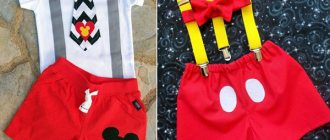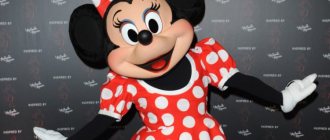Mickey Mouse Birthday
- a great theme for celebrating a boy’s birthday. You will learn about how to organize a Mickey Mouse birthday party, choose a script, games, costumes, decorate a room, a festive table and much more on this selection page.
Mickey Mouse is one of those good guys who is always ahead in everything. Optimism and boyish enthusiasm - these character traits make Mickey a real winner. His sensitive heart and kindness endear him to everyone who knows him. Mickey always remains modest, despite his fame and success. Thanks to all this, Mickey Mouse is the friend everyone dreams of. He is the hero everyone would like to be.
Debut: November 18, 1928 - “Steamboat Willie” First color film: Orchestra Concert Early roles: Fireman, wizard's apprentice, explorer, football player and many others. Hobbies: Sports, spending time with Minnie and Pluto Favorite magazines: Time, Newsweek, Life, National Geographic, Good Housekeeping Pet: Pluto Favorite phrases: “Oh my God!”, “Oh my God!”, “Wow!” "Wow!" Interesting: Mickey's head can be drawn using a 5 ruble coin and 2 10 kopeck coins.
HOLIDAY DECORATIONS for Mickey Mouse's birthday
The main colors to use at a birthday party are a combination of red, black and yellow (orange) for a classic Mickey Mouse birthday party. For the theme “Mickey Mouse. Baby" use a blue color scheme.
Use these colors in balloons and compositions made from them, decorative pom-poms
, in paper garlands, streamers and banners.
Among the paper decorations, we recommend paying special attention to paper pinwheel umbrellas
, in the center of which you can paste a circle with images of Mickey Mouse.
A huge image of Mickey Mouse and (optional) other cartoon characters, Mickey Mouse bows, Mickey Mouse head or ears, gloved hands, drawn or printed are perfect for decorating doors, walls, or a sweet table
and, of course, for a themed photo zone.
Additional decor can be foil balloons, balloon figures or a piñata in the shape of Mickey Mouse and/or with his image.
| Decor of spinning umbrellas “Minnie or Mickey Mouse head” | Funny characters made from paper pompoms |
Interesting Facts
- The recognizable image of Mickey the mouse was created by Ub Iwerks, who worked as a senior illustrator at Walt Disney Studios. His name was not even mentioned in the credits, which was the reason for Aba’s departure from the film studio;
- the name “Mickey” was invented by Disney’s wife, at first the character was named Mortimer, but the smart woman thought that it was too complicated, she needed to choose a simpler option;
- Few people have wondered how old Mickey Mouse is. So this little mouse is a real 32-year-old man in the prime of his life;
- until 1947, Mickey spoke in the voice of Disney himself, but due to suffocating coughing attacks, the studio owner could no longer voice the character;
- Another unsurpassed secret of Mickey Mouse, which Disney “awarded” him, is his gait. She completely copies Charlie Chaplin's movements;
- like any recognized star, the American mouse has been an honorary owner of his own star on the Hollywood Walk of Fame since 1978;
- According to Forbes, Mickey Mouse is the most expensive cartoon character, valued at $5.8 billion.
For your works in Photoshop, paint for Mickey Mouse's birthday
Especially for your creativity for a birthday in the style of Mickey Mouse
This is a useful selection of materials for working in photo editors and Photoshop: clipart on a transparent background, digital backgrounds (textures) for Photoshop, files for editing in psd format, various files in png format (with a transparent background) for inserting photos.
To work with these files, you will need installed programs: Photoshop (psd files), paint - this is a standard built-in program for editing files, you can add inscriptions to JPG or PNG files. Photos in png format frame files must be inserted in photo editors (Photoshop, Illustrator and others).
| Clipart png Mickey Mouse | Metrics for 1 year in the style of “Mickey Mouse” | Metric (poster of achievements) “Mickey Baby” for self-filling |
Birth
In the mid-twenties, the company of the young animator Walt Disney created a series of short cartoons about Oswald the Rabbit for Universal Studios. The popularity of the character exceeded all expectations, and then film producer Charles Mitz decided to independently develop the popular hero. Since the rights to Oswald belonged to Universal under the contract, Mitz stopped further cooperation with Disney and transferred work on the new series to the animators of his own studio. Oswald Rabbit
However, Disney was not going to give up. During a four-day train ride, the cartoonist came up with a new character - a mouse named Mortimer Mouse. Disney's wife Lillian convinced her husband that the name sounded too arrogant, and by the end of the long journey the mouse changed his name to “Mickey.” Together with Ub Iwerks, Disney set to work, and soon the first short film featuring the new character was ready - the animated film Airplane Crazy. But Disney was unable to find distributors for either Airplane or the second film, Galloping on an Ostrich. The company's resources began to dwindle, and Disney poured everything he had left into the creation of a third project, called Steamboat Willie. Many people call Willie the first animated sound film, but this is not true - the Fleischer brothers were doing voiceovers before Disney. However, Walt was the first to achieve synchronous sound - all the actions and movements of the characters in the frame were completely synchronized with the music and other sounds. “Willy” found its distributor, and on November 18, 1928, the long-awaited premiere took place.
Mickey Mouse themed birthday decor
Thematic decor: photo props, masks, posters of numbers - stylized according to the Mickey Mouse theme - this is always a very good and simple technique in order to support the overall style of the holiday. Numbers decor can be used in the form of a poster, figured toppers, balloon pendants. Print out masks and photo props - you're guaranteed fun for the kids.
| Mickey Mouse head garland (layouts) | Greeting banner “Happy Birthday” in the style of “Minnie Mouse” (3 types) | Cap with ears “Mickey and Minnie Mouse” |
| Photo props in the style of “Mickey Mouse and Minnie Mouse” | Templates for Chupa Chups Minnie and Mickey Mouse |
Forward to success!
The success of "Steamboat Willie" exceeded all expectations.
In 1928, talkies were still new, and all of Disney's competitors continued to produce silent films. “Willy” thus stood out from the crowd, and Disney decided to take full advantage of the technical advantage. He added sound to the first two films and again offered distributors a set of all three of his creations. The late twenties were an extremely difficult time for America. After the Stock Market Crash, the Great Depression hit the country, many people lost their jobs, production fell, the birth rate decreased, but Mickey's popularity only grew. The public stood in lines for hours just to admire their favorite character, and enterprising film distributors instantly realized that the inscription “Showing Mickey Mouse” significantly increases cinema attendance. If at first other characters, like Felix the cat, still tried to compete with Mickey, then after a couple of years the mouse established himself as the most popular animated character in America. Over the course of the thirties, Mickey appeared in 87 cartoons, having tried on many roles, from a cowboy and an inventor to a carpenter and a detective.
Mickey grew and developed quite quickly. In “The Fair Seller” he uttered his first words, in “Village Opera” he acquired his signature gloves, and in “The Concert” he appeared before the audience in color for the first time. Mickey's voice was provided by Walt Disney himself; the studio's creator personally voiced his most successful character until the very end of World War II.
Still from the cartoon “Concert”
As Mickey’s popularity grew, so did his character. In the first short films, Mickey was a rather mischievous guy who regularly indulged in jokes that were not at all childish. Gradually, Mickey acquired his own code of honor and became the standard of kindness and integrity. Such a transformation, however, significantly tied the hands of the writers, who were now extremely limited in using the character, so increasingly Mickey began to appear on the screen either in supporting roles or in the company of his friends, the stupid oaf Goofy and the hot-tempered drake Donald Duck.
In 1940, the character's popularity soared even higher when the full-length animated film Fantasia appeared on screens, in which Mickey played the Sorcerer's Apprentice. The audience was completely captivated by the film, which combined advanced animation technology and advanced stereophonic sound with classical music.
Still from the cartoon “Fantasy”
After Fantasia, Mickey was at the peak of his popularity, but then his fame began to decline. During World War II, the studio did not release new series about Mickey, and after the war, new films appeared less and less often, and in 1953, Mickey completely disappeared from the big screens for several decades... However, two years later he triumphantly appeared on small screens screens across the country.
Censorship
In 1936, cartoons featuring Mickey Mouse were banned from showing in Nazi Germany. Historian Gerhard Weinberg in his book “Germany, Hitler, and World War II: Essays in Modern German and World History” gives the following explanations: firstly, Disney was considered a Jew, and secondly , Hitler was outraged by the episode in which Mickey was dressed in a Prussian officer's uniform; Also, since Third Reich propaganda referred to Jews as "rats", Mickey's appearance could have a negative impact on the views of the "true Aryans". At the same time, Hitler himself enjoyed watching these cartoons; they remained popular in the Third Reich. For similar reasons, Mickey Mouse was banned in Fascist Italy (in 1938), Romania (1935, because the giant mouse could scare spectators) and the GDR (as a symbol of American imperialism).
In August 2011, in the city of Tarusa, Kaluga Region, the district court recognized the work of Alexander Savko from the series “Mickey Mouse’s Travels through the History of Art” as extremist material, and in 2012 the work was included in the Federal List of Extremist Materials (item 1271).
Source
Biography
It is not known for certain when Mickey Mouse was invented by Walt Disney, but his official birthday is considered to be November 18, 1928, the day of his debut on the silver screen. The favorite of young children began to appear in white gloves only in 1929, in the film “The Opry House”: this was done so that the mouse’s hands contrasted with his body, because the first cartoons about Mickey Mouse were black and white. This accessory with three black lines on the back (the same folds were on children's gloves) became an individual feature of the character.
Mickey Mouse, Goofy and Donald Duck
During its existence, the tailed hero in red pants managed to transform into various images, and also acquire loyal friends: Goofy, Donald Duck and Pluto. Despite the fact that in some episodes the mouse is courting his friend Minnie, Walt Disney used to say that these characters were married even before the cartoon appeared. Although sometimes they act as if they met for the first time.
“Depending on the plot, Minnie plays the role of a carefree girl or a wife. For ourselves, we decided a long time ago that they were already officially married,” said the creator of the cartoons.
But the illustrator contradicted himself, because in The Barn Dance, which was released on March 14, 1929, Mouse suffers from unrequited love, as Minnie prefers Black Pete to him. Viewers saw in this film Walt’s attempt to pity fans of the cartoon character.
Mickey Mouse and Minnie Mouse
Among other things, the character tried on a soldier's uniform in the film “The Barnyard Battle,” where he fought against cats, and also visited Africa as a tourist.
The first color Mickey Mouse cartoon, "The Concert," was released in 1935 and earned a place on the list of the fifty greatest cartoons. The painting, made in technicolor, tells the story of a mouse conducting an orchestra. But Donald Duck, an ice cream seller, loudly encourages passers-by to buy the treat, thereby preventing Mickey Mouse from concentrating.
Mickey Mouse goes fishing
There are a total of 21 short films featuring Mickey Mouse. The mouse itself changed over time. Also, this hero “starred” in TV series, for example, in “The Mickey Mouse Club”, “House of Mouse” and other multi-part cartoons.
Walt Disney even brought the lovable traveler to full length. In 1940, the film “Fantasia” was released, which became Disney’s most daring idea: the film used new stereo sound “fantasound”, and the plot, where the main character acted as a wizard’s apprentice, resembled abstraction and avant-garde.
Mickey Mouse in a wizard costume
In 1988, Amblin Entertainment released Who Framed Roger Rabbit, a collaboration between cartoon characters and real-life actors. In this cinematic work, which won an Oscar, Mickey Mouse and another iconic character, Bugs Bunny, star of the Warner Brothers studio, met for the first time on the same set.
The popularity of Mickey Mouse is due to interesting plots: fans watch how the main character goes fishing, rides a train, or goes to an unknown country. But his fame is also due to his commercial success.
Mickey Mouse sign
The fact is that the bosses of the animation decided to use a marketing ploy: the company produced and promoted products with the image of a mouse. Roy Disney became the creator of a series of wristwatches with Mickey Mouse on the dial. Today, such an accessory costs a lot of money at auctions.
Disney also uses the “hidden Mickey” method, which is a skillfully hidden Mouse symbol - three circles resembling a mouse’s head. The character is indirectly found in the company’s cult films: “The Little Mermaid”, “Peter Pan”, “The Lion King”, children’s parks, Disneyland and so on. Moreover, only the most attentive cartoon lover will notice the symbol: in “Snow White” it is formed by soap bubbles, and in “The Rescuers” there is a clock with the image of the hero hanging on the wall.
Founder of the empire. Mickey Mouse Anniversary
Archive project “Radio Liberty this week 20 years ago.” The most interesting and significant from the Radio Liberty archive twenty years ago. An unfinished story. Hopes still alive. Could Russia have taken a different path?
David Smith, director of the Disney Archive, Alexander Genis, writer, and Americans - children and adults - talk about the world-famous cartoon character and his creator Walt Disney. Author and presenter Marina Efimova. Broadcast September 17, 1998.
RS in Telegram
RS on Google News
PC in mobile
Marina Efimova : They say that Mickey Mouse was born on a train. I'm talking with one of Mickey Mouse's biographers, the director of the Disney Archives, David Smith.
David Smith : There are a lot of stories about this because the creation of Mickey Mouse has become part of the Disney legend. According to one version, Walt Disney invented Mickey on the train on which he and his wife were returning from New York to California after Disney lost the rights to the cartoons about Oswald the Rabbit. There is some grain of truth in it.
Marina Efimova : David Smith mentioned Oswald Rabbit for a reason, because Oswald was the last draft of Mickey. Before him there was also Julius the cat from the “Alice Comedies” series, which the young Walt Disney made in the early 20s together with several artist friends. It was after these episodes that Disney and his artists were invited to work at the Universal studio, where they made the film Lucky Oswald. But "Lucky" failed miserably. This rabbit clearly lacked charm. Maybe huge round ears? Maybe some ridiculous white gloves? Or maybe the good-natured complaisance and ineradicable carefreeness of our future hero? However, despite the failure of the film about Oswald, professionals instantly sensed a powerful charge of talent in the Disney team. The well-known and even rich animator Paul Terry, who was then famous for taking quantity rather than quality, said thoughtfully after watching “Oswald”:
Announcer : “If you compare us to stores, then Disney operates like an expensive Tiffany’s, and I operate like a penny Woolworth’s, and it remains to be seen who will capture the market.”
Marina Efimova : To prevent a market takeover, the cunning heads of the Universal studio fired Walt Disney himself as a potentially dangerous competitor, and, on the contrary, four of his artists were offered work on unprecedentedly favorable terms. However, all four refused and remained with the fired Disney. It was then, in the fall of 1928, that Mickey Mouse was born. Out of despair. According to legend, Walt Disney named the mouse Mortimer, but Mrs. Disney allegedly rejected the name as too British.
David Smith : When I first came to work at Disney 20 years ago, I had a long conversation with the artist who created Mickey Mouse. It was Disney's first and best animator Ab Iwerks, a Dutch artist whom Walter met and befriended in 1921, long before Mickey was created, in Kansas City, Missouri. They worked together there in an advertising firm. Ab told me how Walt Disney returned from New York, dejected by the failure of his rabbit Oswald, gathered the few artists who still believed in him, and together they began to invent a new hero. But at least one detail in the legend is real. It is true that the name Mickey was given to the mouse by Walt Disney's wife.
Marina Efimova : In infancy, the fate of Mickey Mouse hung in the balance.
David Smith : Disney made two Mickey Mouse movies and couldn't sell them. Silent cinema was dying. And then Walt took his new cartoon, Steamboat Willie, which was almost ready, and introduced sound into it.
Marina Efimova : Let us remember that sound cinema only appeared a year before these events, in 1927, so the scoring of the film “Steamboat Willie” was almost amateur and was carried out by the only technically competent Disney artist Wilfrid Jackson. Recalling his first impression of this first sound cartoon, which decided the fate of Mickey Mouse and his own, Walt Disney wrote:
Announcer : “It was terrible, but wonderful, it was funny, unexpected and new. I have never experienced such a feeling of victory in my life.”
Marina Efimova : And this was said by the author of “Snow White” and “Bambi”?
David Smith : You see, at the time, this film seemed incredibly funny. The main effect was in the sounds and music. After all, before, tap music had no direct relation to what was happening on the screen, but now, when Minnie Mouse twisted the tail of a goat that swallowed her guitar and notes, the goat sounded like a barrel organ and sang the song “Turkey in the Straw” - the main melody of the film . The children watched “Steamboat Willie” ten times. But adults also appreciated his humor, music and artistry. We consider the day of unprecedented success for a cartoon – the New York premiere of the film “Steamboat Willie” – to be Mickey Mouse’s birthday.
Walt Disney presents Snow White and the Seven Dwarfs. 1937
Marina Efimova : This premiere took place in the no longer existing Colonial cinema on September 19, 1928. Mr. Smith, I understand that Mickey Mouse saved Disney from poverty?
David Smith : Oh yes! The company was losing money when Mickey came along. But his films brought in such income that Disney was able to immediately begin preparing feature-length cartoons. The first of these was Snow White and the Seven Dwarfs, released nine years after Steamboat Willie. And look at the difference. “Steamboat Willie” is black and white, short, the image and sound are still of very poor quality. It looks like a rough cut of Snow White. It’s even surprising that such changes in animated films have occurred in just nine years. And yet, it is to Mickey Mouse that we owe the appearance of this Disney masterpiece.
Marina Efimova : If we consider September 19, 1928 as the birthday of Mickey Mouse, then Walt Disney himself considered it the birthday of the Disney Company empire. A quarter of a century later, in the mid-50s, he said:
Walt Disney : “I hope we never forget that a mouse started it all.”
Marina Efimova : Just as cinema began with photography, animation began with a series of newspaper cartoons. She was born in the first decade of the 20th century. At this time, cinema had already become an industry, and newspaper "cartoon's" - a series of cartoons - were established as a genre.
Announcer : “Judging by the legend and Doctorow’s novel “Ragtime”, animation itself was brought to America in its rudimentary form by German emigrant artists, but it was the French film buff Emil Kohl who finally put two and two together. In 1907 he produced the first animated film, Mr. Stop.
Marina Efimova : This is what Adrian Bailey, the author of one of the books about Mickey Mouse, writes and adds: “Walt Disney did not create animated films, he made it an art, a genre. And one of the properties, one of the fundamental requirements of this Disney genre, about which Disney himself wrote a lot, was the vivid personification of the heroes. Mr. Smith, how did Mickey Mouse's character change over the course of his life?
David Smith : In the first films, in his youth, Mickey was an adventurer, he traveled a lot, including to Cannibal Island or in a trailer along mountain roads, as in the film “Mickey Mouse Trailer,” and changed his occupation. But over the years, he becomes a typical representative of the middle class from a comfortable suburb and lives like a normal American.
Marina Efimova : In his first film, “Steamboat Willie,” Mickey was a terrible mischief-maker, albeit a musical mischief-maker. Mickey plays the main melody of the film, the song “Turkey in the Straw,” on everything! A cat howls at him and piglets squeal, which he takes turns pulling by the tails, and he turns a cow, who carelessly opened her mouth, into a xylophone, playing a melody on her teeth.
Mr. Smith, speaking of the character of Mickey Mouse, you mentioned that after a rather turbulent youth, he settled down and turned into a respectable resident of the suburbs. As far as I know, this greatly affected his popularity?
David Smith : Over the years, scriptwriters found it more and more difficult to write roles for Mickey Mouse, because he wasn't allowed to do anything outside the bounds of the respectable ordinary. As soon as he was allowed some mischief, mothers, grandmothers and teachers immediately bombarded the studio with letters demanding that Mickey remain an example without a flaw. Therefore, in the latest films with Mickey Mouse, the main roles, in essence, went to the favorite ugly creature of American children - Donald the duckling.
Marina Efimova : As a result of a survey conducted in America after the Second World War, it turned out that Donald ranks first in popularity, and Mickey Mouse is only third, after the cartoon hare Bugs Bunny. A fairly typical opinion about Mickey Mouse was expressed by Will Brown, with whom our correspondent Raya Weil spoke in a New York toy store.
Will Brown : When I was a kid, I really loved Mickey Mouse, I loved the trips to Disneyland, the parades, in which Mickey is always the main character. Over the years, I realized that Mickey Mouse is an inflated figure. In fact, he is of little interest, he has no character, what is called “personality”. His friend Goofy has a character, although no one knows who he is. And Donald Duck is also a person - harmful, but with character. And Mickey Mouse even has a kind of nasty voice, it gets on your nerves, a kind of whiner. And there are no interesting stories associated with him, not like with Winnie the Pooh - that’s who the real cult figure is!
Marina Efimova : Let's not forget that Mr. Brown's childhood was in the 70s, when the elderly Mickey Mouse left the big screen and came to work in television. As for the movie character Mickey Mouse, then, as always, what some consider squalor, others consider humility. Here's how Disney himself described the character of Mickey Mouse:
Mickey Mouse drawing by Ub Iwerks
Announcer : Mickey is a small creature, but he honestly tries to do every task as well as he can, and he overcomes the obstacles that life throws at him with comic patience and resignation.
Marina Efimova : Many countries have adopted Mickey Mouse from birth. In Italy he was called Toppolino, in Sweden - Mousse Pig, in Japan - Mickey Gucci, in Latin America he was El Miguelito Roton. Only in Russia they didn’t change his name, although they doubled the letter “k” - Mickey. In the United States in 1932, Walt Disney was awarded a special Oscar for the creation of this cartoon character, and during World War II, the actions of the Allied armies on the day of the Normandy landings were designated by the code words “Mickey Mouse.” It's interesting that Nazi propaganda actually hated Mickey. “How can a mouse serve as an example for children?! - wrote one of the leading Nazi critics. “This is one of the most pitiful ideals ever created in cinema.” As funny as it may seem, in Germany, after the Nazis seized power, films with Mickey Mouse were banned. In retaliation for this arrogance, the Americans painted Mickey Mouse faces on all B-17 bombers operating on the European front.
At the microphone is Alexander Genis.
Alexander Genis : It’s even surprising that such a harmless creature as Mickey Mouse had so many enemies. Consider the storm that raged several years ago in France in connection with the opening of a European Disneyland in a Parisian suburb. How much was written then about Mickey Mouse’s “aggression”. Someone even dubbed this park “the French Chernobyl.” Mickey Mouse also irritates our compatriots. Tatyana Tolstaya recently published a most malicious article in Moscow about an unfortunate little mouse, whom she called “the national rodent of America.”
Marina Efimova : What is the opinion among American critics?
David Smith : 20-30 years ago, criticism of all Disney films began by many influential intellectuals. They believed that Disney showed life too smooth, too simple and hid the dark sides of the real world from children. And they were right, including that Disney did not set out to prepare children for real life. He created fairy tales for them, as has been done in all times and in all countries, his goal was to give children pure, absolutely aimless pleasure.
Walt Disney. 1938. Photo by Alan Fisher
Marina Efimova : By the way, Adrian Bailey writes in the book “Walt Disney - a World of Fantasy”: “Even if Walt Disney became a moralist over the years, he did not lose the desire for pleasure and fun.” The 1933 film The Party is typical in this sense. At first, Mickey's guests in his pretty house in the suburbs dance decorously to a slow tune. But the music begins to speed up the tempo and the dancers speed up their movements, the tempo increases, those who had previously watched the dancers join in the dance, then things start dancing - lamps, pots, furniture, the piano itself, which Minnie plays, takes off from its place, and finally the whole house dances. In the end, as befits a respectable suburb, the police appear. A minute later they are dancing too. “I never pretended to be art,” said Walt Disney, “only to entertain the public. But I think there is nothing more difficult in the world than to please the public.” In the 50s, the era of short cartoons in cinema ended and they migrated to television, and with them Mickey Mouse, who made a new career as the host of the nightly children's show “The Mickey Mouse Club”. Something like “Good night, kids.”
Now, at retirement age, Mickey Mouse has become the gracious host of Disneyland - not a bad position for a retired gentleman.
David Smith : But of course the kids that are brought to Disneyland don't know the Mickey movies, they don't even know who Walt Disney is, they think that's the name of the place. But Mickey Mouse has long ceased to be just a movie character; he has become a necessary accessory of childhood. Children love him simply for his appearance. Recently, psychologists tried to show drawings of Mickey Mouse to babies - and they laughed too!
Marina Efimova : Well, well, let's finally listen to the main audience of Mickey Mouse - New York children. Raya Weil talks to them.
Raya Weil : In the largest children's store, which is called "Toys I Us" - "Toys are us" - Mickey Mouse is presented in all forms - from wooden and plastic cubes and a wooden carousel over a child's crib to a huge wind-up singing, talking, flying Mickey. Do you know who this is? - I ask a small African-American girl, whose many pigtails contain multi-colored hairpins with the image of Mickey Mouse.
Angie (5 years old): Yes, I even have a photo of me with him.
Raya Weil : The photo turns out to have been taken at Disneyland. And what did Mickey Mouse tell you?
Angie : Nothing special, he's not the talkative type, but he sang and danced for me. I love Mickey Mouse.
Raya Weil : On a playground in Brooklyn, I got into a conversation with seven-year-old Katie.
Katie : I love Mickey Mouse and Minnie Mouse. To be honest, I'm afraid of mice. Mickey Mouse is also, like, a mouse, but I love him.
Raya Weil : Then my grandmother came up and boasted that Katyusha spoke and read Russian, although she was born in America. Katya nodded her head.
Katie : I have a lot of books about Mickey Mouse, how he was with her, gave her gifts.
Raya Weil : Did you know that he is so old?
Katie : No.
Raya Weil : How old did you think he was?
Katie : Five or six.
Marina Efimova : But, let’s return to the adults, namely Sasha Genis, whom I so impolitely interrupted. He called his essay today “Friends and Enemies of Mickey Mouse.”
Walt Disney and Mickey Mouse sculpture at Disneyland, Tokyo
Alexander Genis : In recent years, many dissertations have been defended at universities across the country on the now very popular topic of so-called “ideological imperialism.” The essence of this concept is that the West imposes its ideological constructs on the third world, flooding it with its mass culture - comics, children's books, cartoons. In this process, the leader, undoubtedly, is the company that gave birth to Mickey Mouse - the Disney Company. Thus, in China alone, two hundred thousand copies of various publications related to Mickey Mouse are published every month. In this regard, at one scientific conference in which I recently had to take part, the following question arose: will Russia become a “banana republic” enslaved by Mickey Mouse? Answering this question, American Slavicist Edith Close said: “By no means! Russian culture is strong and original enough to turn someone else’s into its own. She drew arguments in favor of this conclusion from a comparison of American and Russian animated interpretations of the great Winnie the Pooh. The contradictions here are truly striking. If for the Americans the Rabbit is a teacher, then for the Russians it is a parody pedant. If in the Disney cartoon the donkey Eeyore is a bore, then in the Russian version he is a philosopher. If the Americans have Winnie the Pooh bear just a fat glutton, then among the Russians he is, first of all, a poet, and an esoteric, abstruse, futuristic poet.
It seems to me that such comparisons are, in principle, fruitful and eloquent. A fairy tale is the very first lesson of a specific worldview that makes us all different, so America cannot be understood without Mickey Mouse, and to understand Mickey Mouse, you need to visit his homeland - the Disney amusement park. In the kingdom of Mickey Mouse, you find yourself in a special universe, becoming the object of the directed influence of virtue. They are not so much entertaining you as they are recruiting you, converting you to their faith. A pure nostalgic dream is presented over several hectares. At first glance, nothing special, a typical provincial main street. Street, street lamp, pharmacy... Plus fire department. But all this froze in that ideal time, when not only the streets, but also morals were clean, when there was no crime, drugs, bohemian youths, or racial conflicts. This is the same good old America, faith in which brightened up life for Americans in difficult times. The soul of America belongs to the Disney world, for the Mickey Mouse monarchy is a factory that produces the most necessary product for any country - optimism.
Birth of a character
Disney biographers have differing opinions regarding the exact timing of Mickey Mouse's creation. Various dates have been put forward from late January to May 21, 1928, when Walt Disney applied for the trademark.
Iwerks said in an interview that he experimented for a long time with other species - a frog, a kitten and a puppy. All were rejected by Walt. Michael Barrier refers the reader to Lillian Disney's memoir, according to which, after some reflection, Disney found the mouse an attractive character. Barrier mentions that several years later Disney stated that the choice of the mouse was due to the fact that the Laugh-O-Gram studio in Kansas City, where he worked in the early twenties, was literally overrun with these rodents, as were the cartoons of that time , and he decided to try to tame one.
Criticism and public perception
There is probably no person in the world who has not seen cartoons with Mickey Mouse and his friends. The cartoon itself evoked and evokes extremely positive emotions in viewers of any age, so it is extremely difficult, and seemingly impossible, to find negative reviews about these magnificent works. However, not everything is so simple.
In general, there is a lot to be said about Mickey Mouse as a symbol. Mickey's image has achieved success with a universal audience, bringing happiness and joy throughout the world. The example of Mickey Mouse illustrates the idea that no matter who you are, where you are, or how old you are, happiness is something we can all share with others. Mickey Mouse has the ability to bring smiles to people around the world, and this popular figure helped launch one of the most famous brands. To this day, it serves as a vehicle for the Walt Disney Company to engage people's emotions and promote meaningful experiences that can be shared with family and friends.
However, one must understand that, first of all, Mickey Mouse is used as the main marketing tool of Disney. His face and ears are distributed throughout the world in countless formats to portray and promote the Disney brand. It was Mickey Mouse who, during difficult times, became the focus of intense marketing efforts to increase the company's income. There are certain stereotypes that underlie the perception of Mickey Mouse. The Walt Disney Company works hard to portray itself in the best possible light. By using Mickey as a symbol of happiness and hope, Disney is trying to convince everyone that it truly cares about its audience and that Disney's Adventure Theme Parks are the "Happiest Place on Earth" or "The Place Where Dreams Come True." But if a person does not have the money to buy Disney products or travel to theme parks, then Mickey symbolizes the unattainability of the source of happiness. Therefore, if a person cannot afford to enjoy Mickey, the symbol takes on a negative and sad connotation. And such a perception of Mickey Mouse can lead to a different perception of the mouse, which can change the social meaning of this image.
It turns out that the unconditionally positive perception of the cartoon image of a cheerful and brave mouse sometimes comes into conflict with rather aggressive and annoying methods in promoting various products.
For the vast majority of viewers, Mickey Mouse is, first of all, a source of joy, fun and good mood, which is confirmed by the huge number of his fans around the world. And experts in the field of animation and cinematography have more than once highly appreciated the cartoons about Mickey Mouse, presenting them and their creators with numerous prizes and awards.
Photozone
In the age of active life on social networks and the universal love for numerous beautiful photos, creating a themed photo zone will be a must in organizing a children's birthday.
An excellent solution would be to cover the photo area with a plain fabric, for example, burgundy. Place several chairs and seat cartoon characters on them - Mickey Mouse, Minnie Mouse, Pluto and others. These can be ordinary soft toys. In the background you can hang inflatable balloons, corrugated paper pompoms, and decorative balls. Of course, everything should be in three colors (red, white, black). You can also print out large images of cartoons and hang them up too.
Ratings
Authors of the book “About Mice and Magic. History of the American Animated Cartoons" (Of Mice and Magic: A History of American Animated Cartoons) Leonard Maltin and Jerry Beck note that, unlike other famous Disney characters, for example, Mickey Mouse suffers from one significant drawback - no obvious shortcomings.
In an editorial published as an obituary for the death of Walt Disney (1965), The New York Times wrote: “Disney gave us and the world the friendly and charming mouse Mickey. He will go down in history as the father of Mickey Mouse.”
Replacement for Oswald
Mickey Mouse was created as a replacement for Oswald the Rabbit, whose rights Walt lost due to lack of due diligence. Oswald the Rabbit was created by Iwerks in early 1927. His works were created by Disney and distributed by Universal Pictures. Within a year, Oswald gained fame and began to generate income.
In February 1928, Walt approached Mintz asking for more funding. However, Universal Pictures not only cut production costs for the work provided for under the contract, but also lured away some of the artists and animators. In addition, the rights to the character, according to a hastily signed contract, belonged to Universal Pictures, and it could refuse Disney's services, which served as an important argument in the negotiations. Frustrated, Disney decided to start from scratch.
Walt lost most of his animation team. Together with several dedicated employees, including Ub Iwerks and Les Clark, he began working on a new character in secret while the (no longer his) team continued to work on the Oswald Rabbit cartoons. Walt remembered his first failure well and since then has always carefully monitored the observance of copyright on all works.











